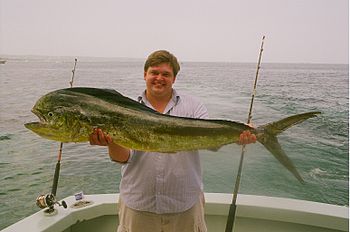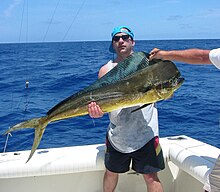Mahi mahi are also known as dorado or dolphin fish. However, they are not at all related to dolphins. Dolphins are air-breathing mammals, whereas mahi mahi are water-breathing fish, distantly related to perch. They are good food fish, similar to flounder and other whitefish.
Description
They spawn in warm ocean currents throughout much of the year, and their young are often found among seaweed. They are a relatively short lived species, with a life span of only four or five years. Mahi-mahi are among the fastest growing fish, with a minimum population doubling time under 15 months. This makes them resilient to fishing pressure.[1] However, their current vulnerability is moderate to high.[5]
Fishing techniques
In earlier years, most mahi-mahi were caught accidentally, as bycatch in tuna and swordfish longline commercial fisheries. Now they are sought by both commercial and recreational fishermen.A typical fishing technique is to take a sport fishing boat to the edge of a reef in about 120 feet (37 m) of water and troll near a line of floating sargasso weed . Mahi-mahi often congregate around marine debris such as floating boards, palm trees and fronds, often found in association with such weed lines.[6] Sargasso sometimes holds a complete ecosystem from microscopic creatures to seahorses, small crabs, juvenile triggerfish and other bait fish. Frigate birds dive for the food accompanying the debris or sargasso. Other fish may be present in the area. Experienced fishermen can tell what species are likely around the debris by the birds' behaviour.
A very different technique uses land based kites, instead of boats and rods, as the mechanism for delivering the terminal tackle at the end of a fishing line. This method has been used to catch mahi-mahi from cliff tops in Hawaii.[7]
In French Polynesia, mahi-mahi are caught with a harpoon. Mahi-mahi don't dive when they are pursued. A specifically designed boat, called the poti marara, is used. This boat is a powerful motorized V-bottom boat, optimized for high agility and speed, and driven with a stick so that the pilot can hold his harpoon with his right hand.[8]
Distribution
Media references
Mahi-mahi, referred to as dorado, are the subject of a significant section of the Yann Martel novel Life of Pi. Martel describes a fight to catch the "writhing mass of pure muscle...with a bulging forehead that speaks of a forceful personality" as "giving me a ride like I imagine a bucking bronco would give a cowboy."Source: From Wikipedia, the free encyclopedia
More Fishing Stories: http://Gofishtalk.com





No comments:
Post a Comment